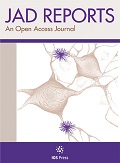Authors: Volloch, Vladimir | Rits-Volloch, Sophia
Article Type:
Research Article
Abstract:
We posit that Alzheimer’s disease (AD) is driven by amyloid-β (Aβ) generated in the amyloid-β protein precursor (AβPP) independent pathway activated by AβPP-derived Aβ accumulated intraneuronally in a life-long process. This interpretation constitutes the Amyloid Cascade Hypothesis 2.0 (ACH2.0). It defines a tandem intraneuronal -Aβ (i Aβ)-anchored cascade occurrence: intraneuronally-accumulated, AβPP-derived i Aβ triggers relatively benign cascade that activates the AβPP-independent i Aβ-generating pathway, which, in turn, initiates the second, devastating cascade that includes tau pathology and leads to neuronal loss. The entire output of the AβPP-independent i Aβ-generating pathway is retained intraneuronally and perpetuates the pathway’s operation. This process
…constitutes a self-propagating, autonomous engine that drives AD and ultimately kills its host cells. Once activated, the AD Engine is self-reliant and independent from Aβ production in the AβPP proteolytic pathway; operation of the former renders the latter irrelevant to the progression of AD by relegating its i Aβ contribution to insignificant, and brands its manipulation for therapeutic purposes, such as BACE (beta-site AβPP-cleaving enzyme) inhibition, as futile. In the proposed AD paradigm, the only valid direct therapeutic strategy is targeting the engine’s components, and the most effective feasible approach appears to be the activation of BACE1 and/or of its homolog BACE2, with the aim of exploiting their Aβ-cleaving activities. Such treatment would collapse the i Aβ population and ‘reset’ its levels below those required for the operation of the AD Engine. Any sufficiently selective i Aβ-depleting treatment would be equally effective. Remarkably, this approach opens the possibility of a short-duration, once-in-a-lifetime-only or very infrequent, preventive or curative therapy for AD; this therapy would be also effective for prevention and treatment of the ‘common’ pervasive aging-associated cognitive decline. The ACH2.0 clarifies all ACH-unresolved inconsistencies, explains the widespread ‘resilience to AD’ phenomenon, predicts occurrences of a category of AD-afflicted individuals without excessive Aβ plaque load and of a novel type of familial insusceptibility to AD; it also predicts the lifespan-dependent inevitability of AD in humans if untreated preventively. The article details strategy and methodology to generate an adequate AD model and validate the hypothesis; the proposed AD model may also serve as a research and drug development platform.
Show more
Keywords: the Amyloid Cascade Hypothesis 2.0, intraneuronal Aβ (iAβ), AβPP-independent generation of iAβ, PKR and HRI kinases, integrated stress response, iAβ depletion therapy for AD, BACE activators as AD drugs
DOI: 10.3233/ADR-220031
Citation: Journal of Alzheimer's Disease Reports,
vol. 6, no. 1, pp. 369-399, 2022





